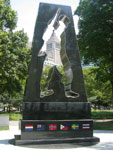Resources for Veterans Day
Once called Armistice Day, Veterans Day has evolved into a day of recognition for all U.S. military veterans, not only those who fought in World War I. This year, the holiday falls on a Friday (November 11), only a week away. How do you celebrate Veterans Day? How do your students celebrate? Do they have veterans in their families? Do they know the history of the holiday? Each student's awareness of Veterans Day and his or her understanding of what it means and how it should be observed will be unique—and ripe for discussion and exploration.

This year, Teachinghistory.org has gathered all of our resources on Veterans Day in one place: our Veterans Day spotlight page. On the page, you can find materials for learning about the history of Veterans Day and the branches of the U.S. military and about the experiences of individual soldiers at war—from the American Revolution to the present day. Get ideas for teaching with monuments and memorials and with oral history, or watch a historian analyze civil war letters. Take quizzes on the 54th Massachusetts (the African American Civil War regiment featured in the film Glory), Operation Desert Storm, and other topics related to veterans and war. (Remember that our previous spotlight pages, on 9/11, Constitution Day, and Columbus Day are still available—and don't forget to visit our new Thanksgiving spotlight.)
If you need more resources, the Library of Congress's Veterans History Project preserves the experiences of thousands of veterans through oral history. The memories of more than 3,000 veterans are featured online, including interview transcripts and audio and video recordings (go to "Search the Veterans Collection" and choose "yes" for "Transcript?" and "Digitized Collection?"). A Library of Congress blog entry gives a quick overview of the Project and ways to use it in the classroom.
At HISTORY.com, you or your students can learn about the Take a Veteran to School program, tweet in honor of veterans (use hashtag #thankavet), or read guidelines for donating photos to the Vietnam Veterans Memorial Fund. The 21-min. online video "The Story of Veterans Day" gives a quick, accessible introduction to the holiday and its history.
For recent materials on Veterans Day, check out the official White House website. Here, you can read Obama's Veterans Day proclamations and find photos and articles on the celebration of Veterans Day in recent years. The Department of Veterans Affairs lists regional Veterans Day observances—and also features a free downloadable teacher resource guide.



